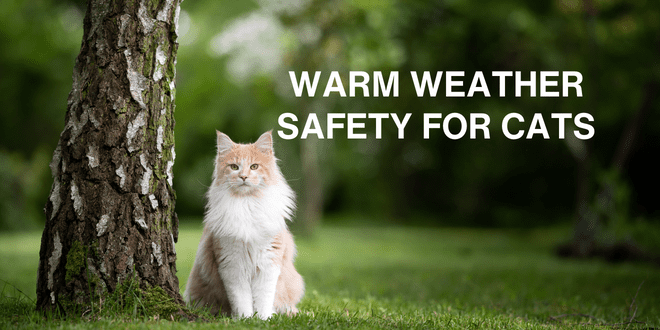
I’ll start off by saying I believe cats are safest indoors unless in a well-constructed enclosure, commonly referred to as a catio. I know many cat parents do allow their cats outside though. If the cat isn’t in a catio-type enclosure, I hope the outdoor exposure is done by being carefully walked with a leash and harness, or in a pet stroller. The indoor vs outdoor debate can bring up emotions as people have strong opinions. I do hope if you let your cat outdoors in whatever way, you create as much safety as is possible.
In summer, many of us look forward to spending more time outdoors, swimming in the pool, going to the beach, firing up the grill, and enjoying the sun. Of course there’s also the joy of mowing the lawn, fighting off mosquitoes, and trying to keep the kids entertained during summer break. As you gear up for summer, this is also the time to think about your cat’s safety, whether an indoor, indoor/outdoor, or strictly outdoor cat. Here’s a quick checklist to get you started:
Flea and Tick Control for Your Cat
If you haven’t already started your cat on a flea preventative, speak to your veterinarian about which product would be best. Even indoor cats are susceptible, especially if you have a dog who could be serving as a flea taxi. Fleas are very hard to spot because cats are such diligent groomers. Check your cat over and look for signs of flea debris. For safety, don’t use any over-the-counter flea control product without talking to your veterinarian first.
Ticks can be very hard to spot. Do a thorough once-over to look for those sneaky little parasites, being sure to check between your cat’s toes, under the tail, and in the armpits.
Appropriate Vaccinations for Your Cat
Regardless of the season it’s important to keep your cat up-to-date on vaccinations as needed. Follow your state or local government laws regarding rabies vaccination. As for other vaccinations, talk to your veterinarian about the appropriate schedule for your cat so you are vaccinating as needed but not over-vaccinating.
Your Cat Needs Fresh, Clean Water
Always make sure there’s fresh water available for your cat. If your cat stays outdoors, keep water bowls in the shade and change them several times a day. For indoor cats, make water as appealing as possible and wash the bowl every day to prevent the buildup of biofilm. In very hot weather, keep water cool by dropping a couple of ice cubes in the bowl.
Watch that your cat (or any pet) doesn’t drink from puddles because of the risk of giardia (a microscopic parasite). The water in puddles may become contaminated from the feces of infected animals.
Climate Control Comfort for Your Cat
If you’re uncomfortable then chances are your cat is also uncomfortable when it comes to the temperature. Even indoor environments can get very stuffy so pay attention to those inside temps. If you don’t have air conditioning keep a couple of fans going to circulate the air. Make sure the fans are safe and placed where the cat can’t get to them. On hot, sunny days, keep curtains closed to help cool down indoor temperatures.
Avoid Sunburn in Cats
Keep in mind that cats can get sunburned as well and their ear tips are particularly vulnerable. On very sunny days, consider keeping your cat indoors for their own safety and comfort. Consult your veterinarian before putting any sunscreen product on your cat because most aren’t safe for pets. Sunblocks containing zinc oxide are toxic to dogs and sunscreens containing salicylates (common in almost all sunscreens) have the same toxic effect as aspirin in cats. The safest sun protection you can use is to bring your cat indoors and avoid extended exposure to sun.
Outdoor Cats Need Access to Shade
Cats allowed outdoors in the heat of the day must have options for shade. Ensure there are shady areas your cat can access. This is also important for people who create outdoor enclosures for cats. There must be shade options within those enclosures and that cats have the ability to re-enter the house on their own. Do not leave cats outdoors in an enclosure in the summer where they can’t escape the heat and return to the house. Never leave cats in an outdoor enclosure when you aren’t home.
Safety for Senior Cats
If you have a senior cat, pay particular attention that she is comfortable since she may not be as mobile and can more easily become over-heated. The best place for an older cat is safely indoors where she can stay cool. Seniors need options for cool surface napping as well as soft beds so they can make the choice to maintain temperature comfort. If you have a fan going in the room, make sure your senior cat is mobile enough to be able to move away from it if she doesn’t like the air blowing directly on her.
Window Safety
Check window screens for any rips or signs of wear that could provide an escape route for a cat. Many cats enjoy sitting in the open window to look outside and you want to ensure that they won’t easily slip out through ripped screens. Check the sturdiness of screens as well. A large and determined cat who spots a bird outside may push through the screen. Screens need to be sturdy and secure and only open windows enough to let the breeze in.
Food Safety Considerations for Cats
Feeding outdoor cats in hot weather can pose a health risk if the food is left out to bake in the sun. There’s also the likelihood of ants, other insects, and even unwanted furry creatures helping themselves to your cat’s food. Don’t leave food out to become contaminated. When feeding outdoors cats, place food in shady areas and don’t leave it out for too long where it can spoil. Be sure you check and replace food regularly.
Groom Your Cat
Frequent grooming allows you to check for parasites, signs of sunburn, or any other things that might need attention. For longhaired cats, having mats can add to the discomfort of the heat so regular grooming will help the skin stay healthier. Thick mats also prevent air circulation to the skin and the cat may end up with a rash. Fleas and ticks also love hiding in tangled and matted hair.
Check Your Cat’s Paws
Look at your cat’s paw pads for signs of burns from walking on hot asphalt or signs of insect stings. Even though your cat’s paw pads feel somewhat tough, they’re actually extremely sensitive and can burn easily.
Grow a Safe Garden for Your Cat
If your cat likes to munch on plants or even likes to munch on the outdoor grass, grow a safe garden of wheat, rye, or oat grass in a container. You don’t want your cat chewing on outdoor grass that could possibly contain chemical weed killers or fertilizers. Grass kits are available at your local pet product store or online.
Your Cat Needs Identification
Have your cat microchipped even if you don’t plan on ever allowing outdoor access. With kids at home more and lots of family activity going on during the summer, it can be easy for an indoor cat to do some door darting. Microchipping is the most secure form of identification. A collar with identification is also a good idea for added insurance but you run the risk of a cat getting hung up by the collar or being able to slip out of it. If using a collar, choose a safe breakaway style. On the ID tag I recommend you put “indoor cat” so anyone who finds her will know she’s not supposed to be outside.
Never Leave Your Pet in the Car
Surprisingly, even though this warning seems very obvious, so many animals die each year due to heatstroke from being left in unattended vehicles. The temperature inside a parked car can escalate very rapidly and the outcome is often deadly.
Watch Your Cat for Heatstroke
If you notice your cat is panting, restless, or has very sweaty paw pads, it may indicate that the heat is affecting her too much. This can lead to heat exhaustion and can then lead to heatstroke. Always make sure your cat has access to shade, water and cool temperatures. Don’t let your cat outdoors on very hot days.
Other Outdoor Cats
This is the time of year when your neighbors may be letting their cats outside more often and as a result, your indoor cat gets a glimpse of an intruder or two wandering through the yard. The sight of an unfamiliar cat in the yard is a common cause of behavior problems (such as elimination outside of the litter box or redirected aggression). Be aware of this as a potential cause of any sudden behavior problems that may occur in your indoor cat if she normally enjoys looking out the window.
If you do let your cat outdoors, keep in mind this may be a time of more cat fights and confrontations. You may think you’re letting your cat outdoors for a relaxing day of chasing butterflies but it may be a day of stress and fighting off the new neighborhood feline bully. Even though fights can happen any time of year, more people let their cats outdoors when the weather turns warmer.
Don’t Forget Your Cat’s Playtime
Your family is spending more time outdoors and having fun but your cat still needs daily play sessions and interaction with you. Keep on a schedule of daily interactive playtime to help your cat stay mentally and physically stimulated. If you don’t have air conditioning, limit indoor playtime to low-intensity sessions so your cat doesn’t become overheated.
Your Cat Needs a Daily Quick Check-over
If you let your cat outdoors, you don’t know what she may have gotten into. When your cat comes back in, do a physical once-over, checking for fleas, ticks, injuries, insect stings, paw pad irritation, sunburn, hydration levels, substances on the fur, and anything else that might need attention.
Wishing you and your cat a safe and happy summer!
Need More Information?
For more specific information on cat behavior and training, refer to the best-selling books by Pam Johnson-Bennett. Her books have been called the “cat bibles” by veterinarians, behavior experts, and cat parents worldwide. Pam’s books are available at bookstores and online. We’ve also included Amazon links here on our website.
If you have a question about your cat’s health, contact your veterinarian. This article is not intended as a medical diagnosis nor is it a replacement for your cat’s regular veterinary care. This article is for general information purposes only.





